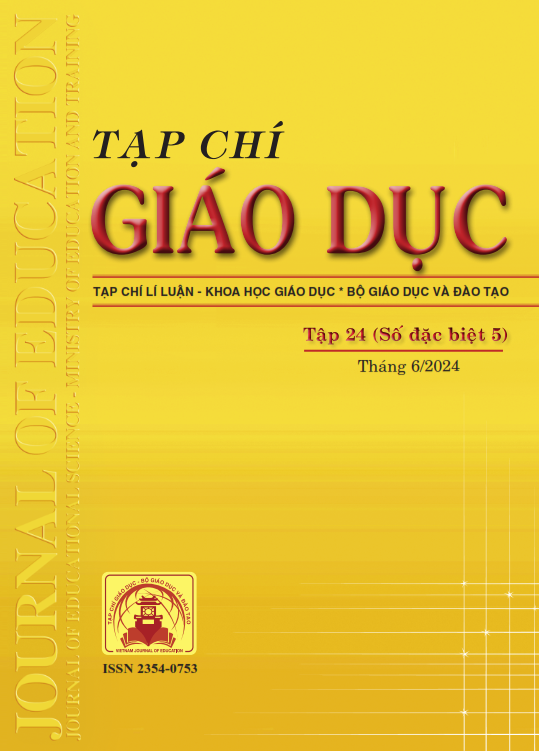Thiết kế bài học STEM chủ đề “Hộp khăn giấy tiện ích” nhằm phát triển năng lực giải quyết vấn đề và sáng tạo cho học sinh lớp 7
Tóm tắt
In the 2018 general education program, problem- solving and creativity competence are among the general competences that need to be developed for students. This competence represents the student's competence to understand and participate in solving problem situations; solve those situations in a method that is new to some extent. The 2018 general education program also specifically emphasizes the role of STEM education, especially STEM lessons in developing students' competence. However, currently there is not much research on teaching STEM lessons to develop problem-solving and creativity competence for students. Within the scope of this article, on the basis of clarifying some basic issues about STEM education and problem-solving and creativity competence, we develop an illustrative lesson plan with the topic “Useful tissue box” in the content of Visual Geometry, specifically through the content “Rectangles and cubes” in Grade 7 Math.
Tài liệu tham khảo
Bộ GD-ĐT (2018). Chương trình giáo dục phổ thông - Chương trình tổng thể (ban hành kèm theo Thông tư số 32/2018/TT-BGDĐT ngày 26/12/2018 của Bộ trưởng Bộ GD-ĐT).
Bộ GD-ĐT (2020). Công văn số 3089/BGDĐT-GDTrH ngày 14/8/2020 về việc triển khai thực hiện giáo dục STEM trong giáo dục trung học.
Burch, G. F., Burch, J. J., & Batchelor, J. H. (2019). Group creative problem solving: The role of creative personality, process and creative ability. Quality Innovation Prosperity, 23(3), 38-54. https://doi.org/10.12776/QIP.V23I3.1286
Charyton, C. (2015). Creative engineering design: The meaning of creativity and innovation in engineering. Creativity and Innovation among Science and Art: A Discussion of the Two Cultures, 135-152.
Hebebci, M. T., & Usta, E. (2022). The Effects of Integrated STEM Education Practices on Problem Solving Skills, Scientific Creativity, and Critical Thinking Dispositions. Participatory Educational Research, 9(6), 358-379. https://doi.org/10.17275/per.22.143.9.6
Hemlin, S., Allwood, C. M., Martin, B., & Mumford, M. D. (2014). Creativity and leadership in science, technology, and innovation. Routledge.
Hoàng Phê (2009). Từ điển tiếng Việt. NXB Đà Nẵng.
Lê Thanh Hà (2021). Xây dựng khung năng lực giải quyết vấn đề và sáng tạo trong dạy học Sinh học phổ thông theo định hướng giáo dục STEM. Tạp chí Khoa học, Trường Đại học Sư phạm Hà Nội, 66(4G), 192-201. https://doi.org/10.18173/2354-1075.2021-0182
Nguyễn Lộc, Nguyễn Thị Lan Phương (2016). Phương pháp, kĩ thuật xây dựng chuẩn đánh giá năng lực đọc hiểu và năng lực giải quyết vấn đề. NXB Giáo dục Việt Nam.
Nguyễn Quang Linh, Peelatom, O., Vilay Thanavong (2023). Bồi dưỡng Năng lực giải quyết vấn đề và sáng tạo cho học sinh thông qua hoạt động trải nghiệm “Nguồn điện xanh”. Tạp chí Giáo dục, 23(5), 35-40.
Nguyễn Thị Hoài Phương, Lê Hải Mỹ Ngân (2022). Thiết kế và tổ chức dạy học trực tuyến bài học STEM “Mô hình nhà nổi chống lũ”, môn Khoa học tự nhiên lớp 8. Tạp chí Khoa học, Trường Đại học Sư phạm TP. Hồ Chí Minh, 19(12), 1989-2001.
Nguyễn Thị Nhị, Lê Xuân Trí (2020). Phát triển năng lực giải quyết vấn đề và sáng tạo cho học sinh khi dạy học chủ đề “Máy bơm nước tự động” ở trường trung học cơ sở theo mô hình giáo dục STEM. Tạp chí Khoa học Giáo dục Việt Nam, 32, 27-31.
Nguyễn Trọng Đức (2022). Phát triển năng lực giải quyết vấn đề và sáng tạo cho học sinh thông qua dạy học phân môn Địa lí cấp Trung học cơ sở. Tạp chí Giáo dục, 22(14), 36-42.
OECD (2010). PISA 2012 Field Trial Problem Solving Framework, Draft Subject to Possible Revision after the Field Trial.
Yamak, H., Bulut, N., & Dündar, S. (2014). The impact of STEM activities on 5th grade students’ scientific process skills and their attitudes towards science. Gazi University Journal of Gazi Education Faculty, 34(2), 249-265.
Đã Xuất bản
Cách trích dẫn
Số
Chuyên mục
Giấy phép

Tác phẩm này được cấp phép theo Ghi nhận tác giả của Creative Commons Giấy phép quốc tế 4.0 .












